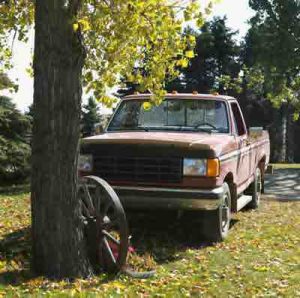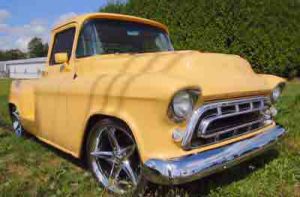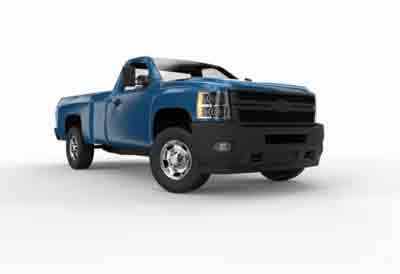For those who do not know, tires actually do wear out. They suffer from wear and tears like every other thing on earth. A worn-out tire is, in literal terms, a damaged tire.
A worn-out tire is an old tire that is no longer usable and therefore, unsafe.
According to oponeo.co.uk, ‘a worn tire is a tire with a tread depth that has reached the treadwear index marked in several places around the circumference’.
Table of Contents
Which amongst the tires wear out faster on a pickup truck?
If your pickup truck is a front-wheel drive then your front tires will wear out faster than the rear ones, and if it is a rear-wheel drive, the rear tires will wear out faster than the front ones.
In order to correctly ascertain which of the pairs of tires wear faster, we need to know and be sure of where the driving axle is placed.
This is because tires that are on the driving axle will be subjected to much more stress than the ones that are not.
We can identify where the driving axle is placed by checking if the vehicle is a front-wheel drive or a rear-wheel drive.
Front-wheel drives have their driving axle in front, while in contrast, rear-wheel drives have their driving axle at the rear.
Since most vehicles manufactured today are front-wheel drives then we can unanimously agree that the front tires of your pickup truck are bound to wear out faster than the rear ones.
Therefore, you should begin to pay extra attention to those front tires because from the moment you had the first drive on them, they started wearing out.
Paying attention to the front ones does not mean you should neglect the rear ones. Check all of them.
The one that wears faster why does it?

There are many reasons that could lead to the wearing out of your tires – the front ones especially – apart from being placed on the driving axle. We will be discussing a few of them below;
The front tires wear quicker because they are the ones that perform the steering of the vehicle and therefore move much more often than the rear tires.
Every time the steering wheel is turned, the front tires generate friction as they have to rotate against the road.
To further buttress this, your front tires will wear out faster and quicker because the majority of the breaking comes from the front.
More friction, more wearing.
An undeniable factor that contributes to the wear of the front tires is that they, generally, take more impact than the rear tires.
Road hazards like potholes, debris on the road, hitting curbs, and many more will continually cause the front tires to degrade fast and also make them more susceptible to punctures.
I guess we can assume that the road itself is not kind to front tires.
This third reason will get a lot of people surprised and it is that front tires wear fast because they carry the majority of the load of the vehicle.
A lot of people tend to think because passengers sit towards the back then there is not much load on the front tires but that is not the case.
There is a lot of weight from the engine which causes serious wear on the front tires than the rears. You do not believe? Try carrying the full engine of your car or pickup truck.
Also on this particular reason, some people argue that due to the load that pickup trucks carry, which are most of the time always towards the back of the car and on the rear tires, the rear tires should wear out quicker.
Yes, the rear tires majorly bear the weight of the load but we forget that the front tires will get a share of that and yet still carry the engine as it normally does then also face the friction on the road plus the whole movement control.
Oh, can we give the front tires a break, please!
Your tires will wear out very fast if the air pressure in them is not optimal. Yes, improper air pressure in any of your tires will cause it to wear out faster than it should.
Under-inflated tires will most likely wear out on the outside edges of the tread while an over-inflated tire will show wear and tear in the middle of the tread.
Ensure that you keep your tires properly inflated to get them to last longer.
Lack of rotation is another major cause of tire wear. Having identified that, generally, the front tires wear out faster, it is important that you rotate them with the ones at the rear on a timely basis.
Not rotating will make the front tires susceptible to more serious damage.
Most manufacturers of vehicles recommend that you rotate your tires after every 5000-7500 miles but if you find it hard to keep that in mind, try rotating your tires every time you do an oil change.
Improper wheel alignment is described as the worst culprit of tire wear. Wheel alignment is the mechanical adjustment of your vehicle in such a way that it causes your wheels to roll smoothly when on the road.
It is simply the adjustment of the angles of the wheels so that they become parallel to each other and perpendicular to the ground.
An improper wheel alignment can cause the insides of your front tires to wear very quickly while the outside of the tire remains good.
How often should you perform maintenance on your pickup truck tires?
There is not a laid down or specific number of days or weeks that you must check on your tires.
But it has been established that tires depend on good tread condition depth in order to maintain traction so it is advised that you do a tread check-up at least once a month.
Furthermore, the National Highway Traffic Safety Administration (NHTSA) in the United States of America recommends that all tires must be replaced after every six (6) years not minding the number of miles driven.
This, invariably, means that all tires are deemed expired after six (6) years of usage.
Please note that this does not mean that you should not check the tires during the six years of using them. Do not assume that it will be in perfect condition for 6 years.
You see, there should be no debate on if you should do a maintenance check on your tires or not because whether you are trying to save money or improve the safety of your vehicle, tire maintenance is important and paramount.
What most people do not know is that carrying out regular maintenance on your tire will help you avoid unexpected costs of having to replace your tires and also help you avoid paying hefty fines for not abiding by the law.
Maintenance tips for your pickup truck’s tires to increase their lifespan

It might sound scary knowing that for every mile you drive, your tires are diminishing in power, but you do not have to worry about all that because there are some maintenance tips or hacks that can help you increase the lifespan of your tires.
Some of them are;
Maintain Proper Tire Inflation Pressure
To get the best performance out of your tire, you should ensure that the inflation pressure is at the recommended level.
A proper inflation pressure does not only guarantee you an optimal tire performance, it also increases the level of safety and helps you economize fuel consumption.
To know the recommended level of inflation pressure, check the vehicle’s placard or owner’s manual.
This maintenance tip is vital because under-inflation in tires is the major cause of irreparable damages to tires.
Under-inflation causes severe cracking and leads to air loss. It also reduces load capacity while increasing rolling resistance which then results in heat and mechanical damage.
The other one is Over-inflation. This one increases tire stiffness which makes driving really uncomfortable.
With over-inflation, there will be unwanted vehicle vibration and there may be severe impact damage.
Now you understand why maintaining a proper inflation pressure is the most important maintenance tip that helps your tires stay durable and last longer.
Do not spin your tires excessively
I know how frustrating it can be when your car is stuck in the snow, sand, or mud but always rebuke the urge to spin your tires.
Spinning your tires in these conditions may cause your tire to over-heat and ultimately, it may cause irreparable damage.
To get yourself out of such annoying situations, use a gentle backward and forward rocking motion till you are free.
When most people are stuck in the mud, spinning the tires becomes the next line of action, and this does not just cause harm to the tire, it also sprays mud all across the road and onto oncoming passers-by.
Do not spin your tires so you will not spoil your tires and other people’s day.
Always check your tires for wear
We have already established earlier in this article the importance of regularly checking your tires for wear and tear.
It is one of the most important maintenance tips because if you do not check you will not be aware of how damaged it has become.
So, make it a point of duty to constantly go down on your tires.
Remove the tires completely when they reach 1.6mm remaining in tread depth.
All new tires now have tread indicators that appear as smooth banks in the tread grooves when they wear to the 1.6mm point level.
Tires that are seriously worn are prone to weather accidents like skidding on a wet road.
Check your tires for damage weekly
Similar to the tip above, it is important that you do a frequent examination of your tires for any kind of damage and overall condition.
You can do this yourself or better still, have your tire dealer or tire engineer do an expert inspection on the tires because damages like impacts, penetrations, cracks, bulges or air loss require the tire to be removed and thoroughly checked.
Do not overload your vehicle
This is another major cause of tire damage. Overloading your vehicle demands too much strength and effort from your tires.
Remember to check your owner’s manual to know the load limit for your vehicle. Overloading causes poor handling, increased fuel consumption, and irreparable tire damage.
Another aspect of this you should take note of is that do not fit tires that have less load capacity than shown in the vehicle placard or owner’s manual.
The makers of the vehicle know the right load capacity that the tires of the vehicle should have.
Other tire maintenance tips that are just as helpful as the ones above are;
Rotate your tires
Since we already know that the front tires suffer more wear, it is helpful that you switch the front and rear tires after some time to allow the wear to spread evenly on all four tires.
It is advised that you rotate your tires according to the instructions on the vehicle’s owner’s manual or you could also rotate them at a maximum interval of 6000mi or 10000km.
Conclusion: Do front or rear tires wear faster on rear-wheel drives?
Like we discussed above, if a vehicle is a rear-wheel-drive then it must have its driving axle at the back or in this case, the rear.
This means that the rear tires are the ones doing most of the driving. Therefore, they will be subjected to harsher conditions like the front tires in a front-wheel drive.
So, the rear tires will wear faster and quicker in a rear-wheel drive.
I believe this article has answered a lot of your questions about which of your tires wears out faster and also provided you with helpful tips on how to maintain them so they can last and serve you for longer.

